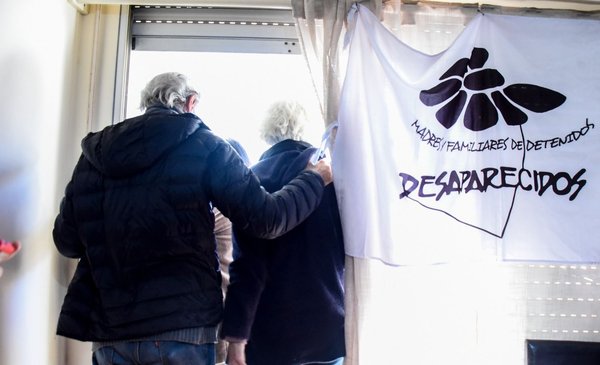Less than two tiles deep, on the morning of Tuesday, June 6, an “almost complete skeleton” was found in Battalion 14. The head pointed to the south and the feet to the north. The body had been buried—or rather thrown into a pit—upside down with its head to the side. For the forensic anthropologist Alicia Lusiardo there are no doubts: “It is a clandestine burial, a body that received treatment and with obvious intentions of concealment (by the lime and the slab) ands a burial of a missing prisoner“of the last civic-military dictatorship.
This Thursday, 16 days after the discovery, the team of anthropologists led by Lusiardo reported that the remains found are of a woman. They know it from the shape of the skull and part of the pelvis, but also from the comparison of the size of the bones with metric standards.
This data reduces the chances of knowing who it is. Of the 197 disappeared detainees, only 45 are women and there are remains of six that have already been found (all outside of Uruguay). The list, therefore, is reduced to 39. In the press conference given this Thursday by the organization Mothers and Families of Uruguayans Detained and Disappeared, it refers to 40 cases, because they include Renée Pereira whose remains, according to the official record, were found in Argentina.
Along with the bones found in the 14th Battalion, there were no pieces of clothing, coins, jewelry or any other cultural element that would allow us to risk hypotheses. Even the deterioration of the extremities of some remains made it impossible to estimate the age of the murdered woman. That is why the anthropologist Lusiardo was blunt: only the DNA test —scheduled for the next few weeks in a Cordovan laboratory— will reveal her identity.
Ines Guimaraens
From the size of the bones and the shape of the skull, anthropologists concluded that it was a woman.
The relatives of the disappeared asked that a dance of names not be started because the mere mention of one of them means removing the anguish-anxiety with which they carry. Why, despite the warnings, did it begin to be rumored that it could be María Claudia García de Gelman?
50 years after the coup, one of the problems that continues to arise is silence and the lack of accurate information. Faced with this data gap, a few clues are enough to build hypotheses of possible whereabouts.
In the official files that the Uruguayan Human Rights Secretariat compiled on each of the 39 disappeared women who are still being sought, almost all key data is missing. In particular, there is a lack of information about where they were last seen and, above all, what happened to them.
It is known that 36 of the 39 were detained and kidnapped between June 1976 and September 1978. The remaining three escaped during that period: Nelsa Zulema Gadea (December 1973), María Rosa Aguirre (November 1974), and María Elsa Garreiro. (August 1979).
The dates matter because, according to historians, they could be linked to different repressive operations. For example: the two bodies of men found in the 13th Battalion of Uruguay corresponded to arrests in the so-called Operation Morgan against the Communist Party, while the bodies of Julio Castro and Ricardo Blanco found in the 14th Battalion responded to later operations.
What do those disappeared whose remains were found in Battalion 14 where the third body (and that of a woman) have now appeared in common, beyond the date? The institutional responsibility for the operation had been the Defense Information Service (SID).
The same official files suggest that the SID was responsible for the disappearance of at least 17 of the 39 women being sought. But again, the data is not always compelling. In many cases there is evidence (as with García de Gelman), in others there are specific suspicions of transfers from Argentina to Uruguay within the framework of the Condor Plan and therefore that Uruguayan repressive body would have participated, and in others the link is thought by the places where they were detained in Buenos Aires (“Pozo de Banfield”, “Pozo de Quilmes”, Automotores Orletti).
The SID was a service divided into five departments that concentrated the national and international records of those required, an administrative area, an infrastructure area, and the feared operational unit (made up of José Nino Gavazzo, among others) whose welcome sign warned: “You You are entering Dept. III SID POE. If you come as a friend, welcome. If you come as an enemy, we’re sorry for you.”
From the list of names, García Gelman is the only case in which, for now, it is exactly known that she was arrested in Argentina, transferred to Uruguay and last seen in Montevideo. In fact, the grave where the skeleton was found is “approximately 130 meters from the initial point” where the burial place of this shoe factory worker had been indicated, recognized the anthropologist Lusiardo. And 130 meters in tens of hectares of forest is equivalent, according to the technicians, to extreme proximity.
When and why was García de Gelman transferred to Uruguay?
At dawn on August 24, 1976, six armed men broke into the house where this young worker in the shoe industry lived, in the Almagro neighborhood of Buenos Aires. She, 19 years old and seven months pregnant, was detained along with her husband and her sister-in-law (both sons of the poet Juan Gelman).
Despite the fact that her political and trade union membership is unknown, the kidnappers accused her of being a “montonera”, in reference to the Argentine guerrilla group. She was confined in the clandestine detention center “Automotores Orletti” and, in a joint operation between the Argentine SIDE and the Uruguayan SID, she was reportedly transferred to Montevideo on October 7, 1976. The conditional condition is not due to the confirmation that she was transferred, in fact the evidence confirmed that she was part of the exchange between the repressors on both banks of the Río de la Plata within the framework of the Condor Plan. The conditional is because the exact date of that movement is handled as “probable”.
Julio César Barboza, one of the few soldiers who broke the silence and gave key information despite not having held senior positions, recalled seeing her, pregnant, on the top floor of the clandestine prisons in the SID building on Bulevar Artigas and Palmar (where today the National Human Rights Institution that searches for the disappeared works). She was with Anatole and Victoria Julien, children of detained-disappeared.
The second and last time that the ex-soldier Barboza saw García de Gelman, it was a night when “there were almost no lights on” in which the repressors Ricardo Arab and José Antonio Rodríguez Buratti took their newborn daughter in a basket ( Macarena), given birth at the Military hospital. It was then that Arab said: “Sometimes you have to do tricky things.”
Macarena Gelman told The Observer that he is “expectant and anxious” in case the remains found are his mother’s, “and also with the comforting feeling that regardless of this particular identification, there is a strong possibility of continuing to find more companions. That if it is not this time it will be later ”.

Ines Guimaraens
Work in the 14th Battalion where the remains were found
Unlike García de Gelman, there are two other missing persons who are also known to have been kidnapped in Uruguay and were last seen in local clandestine detention centers. They were not transferred to Argentina as happened with some piles trapped in national territory. This is Elena Quinteros, arrested in June 1976 and some testimonies say they saw her for the last time in the hell of “300 Carlos”, the detention center very close to where the bodies of the 13th battalion were found; and Amelia Sanjurjo, who was arrested in November 1977 and was seen for the last time at La Tablada. The table? It coincides that Ricardo Blanco, found in the 14th battalion, went through that clandestine jail.
As the data is few and the options many, it only remains to hope that science demonstrates with the DNA test who it is and thus the family of one of these 39 women will be able to recover some peace.

















